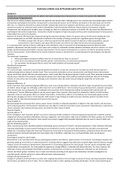Samenvatting
Summary articles of the lectures Loss & Psychotrauma
- Instelling
- Universiteit Utrecht (UU)
In this document i have summarized the articles we needed to study for the lectures. (this does not include the articles of the workshop or notes from the lectures). It is for the course Loss & psychotrauma - master Clinical Psychology - Utrecht University.
[Meer zien]




